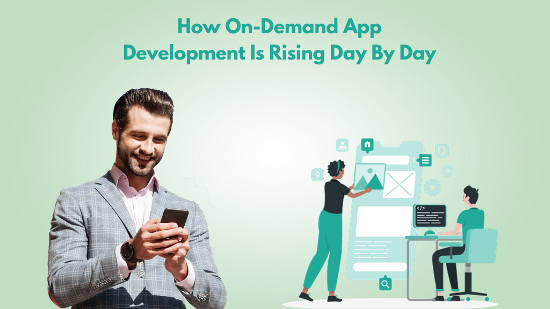The phrase “On-Demand App Development” is relatively new in IT. For an industry that influences its innovations in others, a new branch of development is rare. Over the years, the on-demand niche has been the go-to means of making your business popular. It has successfully merged applications with the marketplace. But how is it that this new phenomenon has yet to uncover its true potential?


Introduction
People who are used to relying on technologies aren’t only helping themselves but also app developers as well. But the heart of all the sources comes from the people whom the app is really made for. Hence, developers are changing the on-demand landscape using customer feedback as a part of their ongoing development.
The On-Demand Arc of Involvement
To understand what brings a change to an app’s feature, you have to understand the goal behind its development. Popular on-demand features like multiple payment choices and live tracking have been a solid bedrock for businesses to thrive in the long run.
If you are starting an on-demand business, integrating these features is simply part of the app’s development process. To increase customer involvement, app developers build an easy-to-use, minimalist, and smart navigational app interface. This is how your customers can feel valued rather than confused.
Instead, implement a customer feedback loop to gain critical insights about your on-demand business from the perspective of the users.
This feedback, both positive and negative, when taken into account, shows a brand is really interested in its customer’s opinions.
For example, Gojek, Indonesia’s leading on-demand company, used data to depict changes in their customer’s behavior. Gojek’s on-demand model delivers food, groceries, and parcels, as well as other items, every day to millions of users. It demands a great deal of networking coupled with route optimization-based technology that makes their business prosper. Therefore, app developers quickly realized the untapped potential of their logistical ability to connect their drivers and customers.
Gojek introduced six different segments in their service as a part of their ongoing digital transformation model. These services especially target those customers who come from a working background and use their app for convenience and ease. Essentially, they wanted to know more about their customers and introduced new services to increase their involvement. Most companies, especially those that cater to smartphone-based apps for their operations and branding, use data to reflect changes.
But there’s more than what really connects the dots.
Determining User Preferences for Brand Loyalty
One of the critical things that really changes the whole in-app experience starts with the preferences of the user. Prioritizing preferences in the initial stages of the development process helps the new on-demand business find its niche voice. It is done through surveys, user testing sessions, or an in-app mechanism that outlines the direction of the app development process. If done right, the brand can quickly change the local on-demand market, competing head-to-head with the leading giants.
For instance, Uber Eats, GrubHub, Postmates (which Uber recently acquired), and DoorDash control America’s restaurant food delivery market. Leaving no choice, these restaurants must pay whatever fees and commissions these on-demand companies charge. However, small food businesses emerging with the help of ghost kitchens are changing the wave of the on-demand model. Most people in the survey stated that they are likely to pay those more rather than support the big ones.
That’s the power user preference holds in the face of branding. Furthermore, app developers take these preferences and connect them with user feedback to prioritize which ones to start with. With quick upgrades, users will start to personify your business and see it as a ‘person’ who cares about them.
Saving Costs and Minimizing Risks
High app development costs are a substantial barrier for entrepreneurs. If you spend too much, the gap for post-launch maintenance becomes large and often becomes a key factor in app failure. However, solving issues or design flaws at an early stage of an on-demand app development process is a viable solution. Not only does this allow the app to meet the user’s expectations, but it also avoids unnecessary spending.
For example, in the BlaBlaCar carpool app, users were having a hard time finding the driver’s details in the app. This led to multiple upgrades in the section that showcased the driver’s profile to the user. Finally, the search result page became the desired driver’s profile section, accessible with a simple right swipe.
Think about this change and recent developments. Companies all over the globe that are in the on-demand ecosystem of business are bound to listen to their users. It has been the most consistent app development trend that holds the leading edge for most on-demand competitors.
A Source For Innovation
If you have a fresh business idea, consider turning that idea into an indispensable product, i.e., an app. Look everywhere to understand the innovations in the on-demand market at large. As this market has matured, a new app could have difficulty making a difference. That is why you can opt for a solution that doesn’t compromise anything related to your app’s features and design.
Many app owners who don’t want to spend an excessive amount of money on development often face this issue. They turn to a pre-built solution, a prevalent choice, as it has many benefits.
Pre-built Solution For Your On-demand Business
Most entrepreneurs don’t want to spend too much of their time setting up a business in the digital landscape. They cannot be blamed, as the technology has come so far that making an app over months sounds ancient. What really takes time is to understand the customer demographics to create a marketing plan for the app to launch. Along with this, there is also the look and feel of an app for different services.
Here, the popular choice of opting for a pre-built on-demand solution comes as a time savior to tackle all these issues. Having a pre-built app means that it has already been developed and is ready for launch. You must test all the features and functionality and buy its source code for further customization.
Compared to developing the app from scratch, this solution is built for business-savvy entrepreneurs who want results before action. Moreover, with an app that offers similar features, you have the leading edge to make quick changes on the go. Once you buy the clone script from a white-label firm, they will rebrand it as per your business needs. Details like your business name, logo, and color schemes, along with payment, language, and SMS gateway, will be added. This process takes around 1-2 weeks to finish, which is far more advanced than the standard on-demand app development process.
Conclusion
The mobile app industry continuously evolves to find ways to make user engagement with the app more interactive. By truly listening to the feedback, backed with relevant data and an impeccable app design, you can easily flourish and thrive in the on-demand market for the long run. Find a white-label firm with decade-old experience in this niche and inquire about the cloning process. The more you learn about app development, the more you’ll grow as an on-demand pioneer.
























